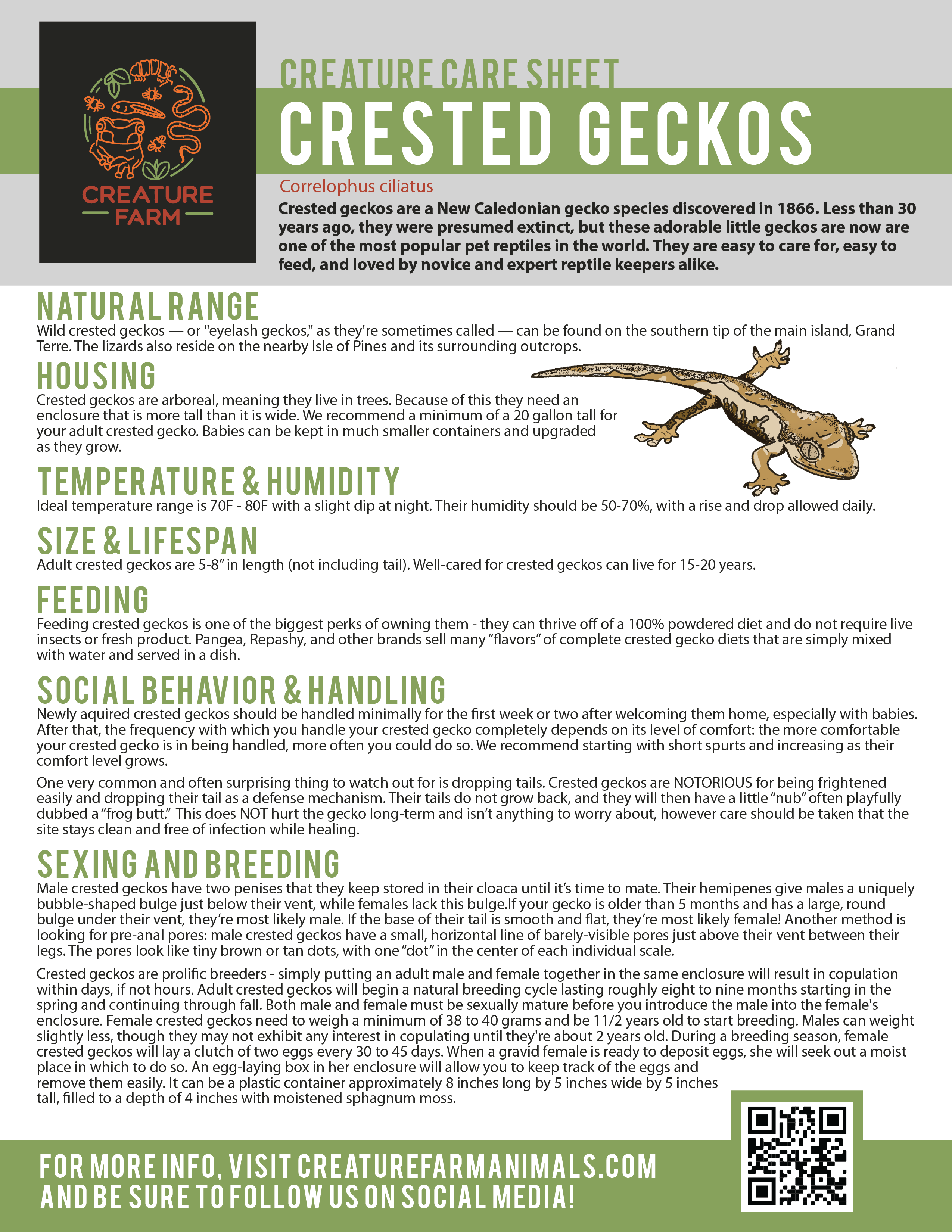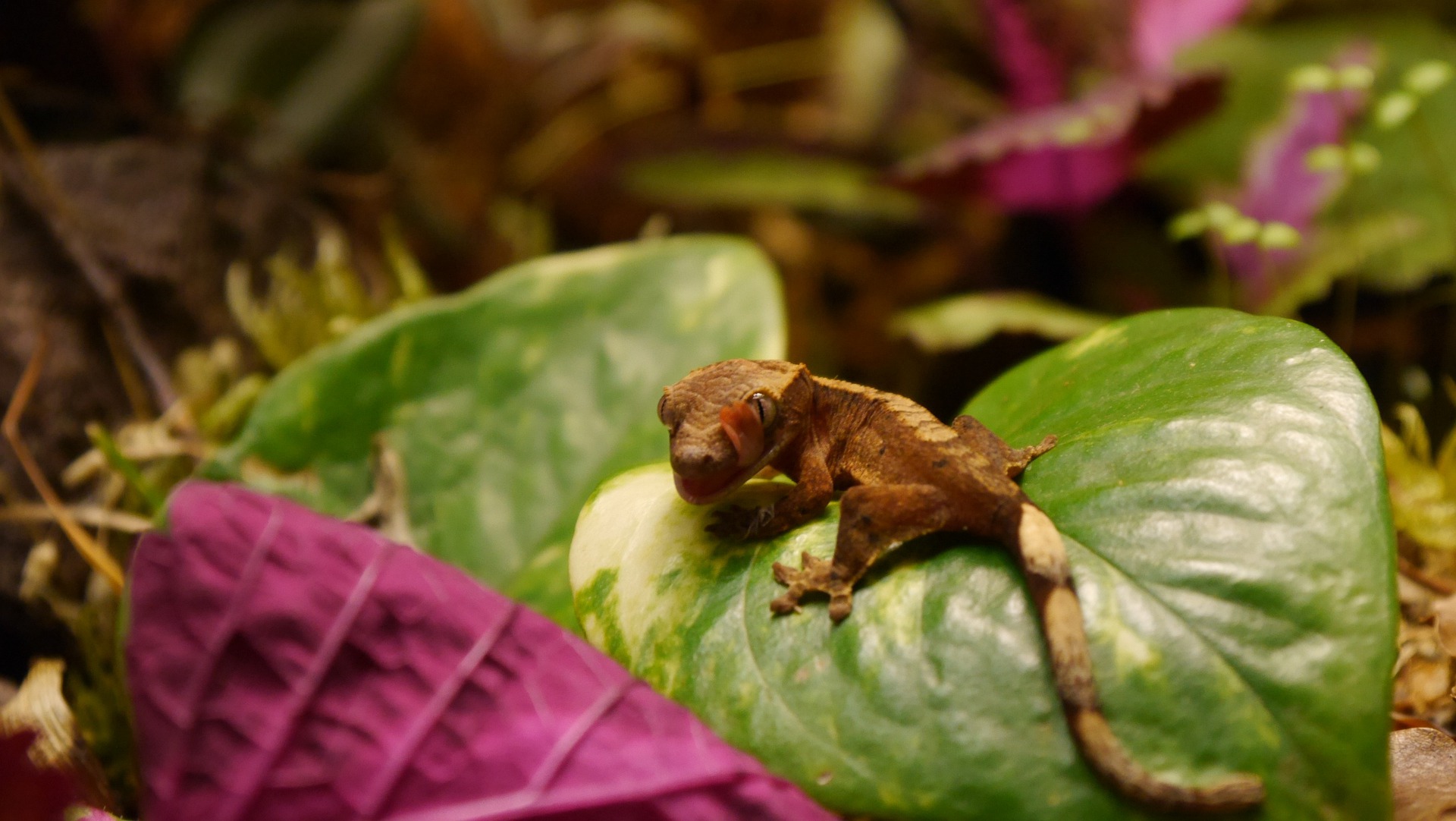CARE GUIDE
Correlophus ciliatus
Crested geckos are a New Caledonian gecko species discovered in 1866. Less than 30 years ago, they were presumed extinct, but these adorable little geckos are now are one of the most popular pet reptiles in the world. They are easy to care for, easy to feed, and loved by novice and expert reptile keepers alike.
NATURAL RANGE
Wild crested geckos — or “eyelash geckos,” as they’re sometimes called — can be found on the southern tip of the main island, Grand Terre. The lizards also reside on the nearby Isle of Pines and its surrounding outcrops.
HOUSING
Crested geckos are arboreal, meaning they live in trees. Because of this they need an enclosure that is more tall than it is wide. We recommend a minimum of a 20 gallon tall for your adult crested gecko. Babies can be kept in much smaller containers and upgraded as they grow.
TEMPERATURE & HUMIDITY
Ideal temperature range is 70F – 80F with a slight dip at night. Their humidity should be 50-70%, with a rise and drop allowed daily.
SIZE & LIFESPAN
Adult crested geckos are 5-8” in length (not including tail). Well-cared for crested geckos can live for 15-20 years.
FEEDING
Feeding crested geckos is one of the biggest perks of owning them – they can thrive off of a 100% powdered diet and do not require live insects or fresh product. Pangea, Repashy, and other brands sell many “flavors” of complete crested gecko diets that are simply mixed with water and served in a dish.
SOCIAL BEHAVIOR
Crested geckos are safest housed alone, however if enough room is available, females can sometimes be houses in pairs or small groups. This can also be done in male/female pairs or groups with one male to multiple females. More than one male should NEVER be housed together in the same vivarium. They are extremely territorial and will fight, often to the death.
Newly acquired crested geckos should be handled minimally for the first week or two after welcoming them home, especially with babies. After that, the frequency with which you handle your crested gecko completely depends on its level of comfort: the more comfortable your crested gecko is in being handled, more often you could do so. We recommend starting with short spurts and increasing as their comfort level grows.
One very common and often surprising thing to watch out for is dropping tails. Crested geckos are NOTORIOUS for being frightened easily and dropping their tail as a defense mechanism. Their tails do not grow back, and they will then have a little “nub” often playfully dubbed a “frog butt.” This does NOT hurt the gecko long-term and isn’t anything to worry about, however care should be taken that the site stays clean and free of infection while healing.
SEXING AND BREEDING
Male crested geckos have two penises that they keep stored in their cloaca until it’s time to mate. Their hemipenes give males a uniquely bubble-shaped bulge just below their vent, while females lack this bulge.If your gecko is older than 5 months and has a large, round bulge under their vent, they’re most likely male. If the base of their tail is smooth and flat, they’re most likely female! Another method is looking for pre-anal pores: male crested geckos have a small, horizontal line of barely-visible pores just above their vent between their legs. The pores look like tiny brown or tan dots, with one “dot” in the center of each individual scale.
Crested geckos are prolific breeders – simply putting an adult male and female together in the same enclosure will result in copulation within days, if not hours. Adult crested geckos will begin a natural breeding cycle lasting roughly eight to nine months starting in the spring and continuing through fall. Both male and female must be sexually mature before you introduce the male into the female’s enclosure. Female crested geckos need to weigh a minimum of 38 to 40 grams and be 11/2 years old to start breeding. Males can weight slightly less, though they may not exhibit any interest in copulating until they’re about 2 years old. During a breeding season, female crested geckos will lay a clutch of two eggs every 30 to 45 days. When a gravid female is ready to deposit eggs, she will seek out a moist place in which to do so. An egg-laying box in her enclosure will allow you to keep track of the eggs and remove them easily. It can be a plastic container approximately 8 inches long by 5 inches wide by 5 inches tall, filled to a depth of 4 inches with moistened sphagnum moss.



